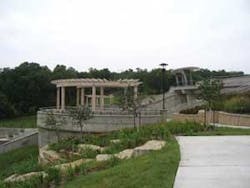Rain to Recreation: Recasting Stormwater Runoff as a Water Resource Asset
By Donald W. Baker and Michael T. Beezhold
If you ask civic leaders in Lenexa, KS, how their city turned a stormwater runoff problem into a community asset, they’ll probably attribute the development and implementation of Lenexa’s successful stormwater management program to thinking outside the box or pipe—or at least looking beyond traditional perceptions of stormwater runoff as a liability that requires traditional solutions, such as box culverts, to carry away excess water.
Widespread practices of channeling and concrete lining of natural streams and clearing of riparian corridors and associated floodplains are giving way to more environmentally friendly approaches. Lenexa’s Rain to Recreation program, including the Coon Creek Watershed Study and award-winning Lake Lenexa Dam and Spillway, is an excellent example of one community’s ability to look at an old problem in a new light.
Lenexa is a suburban community of nearly 50,000 residents in the southwestern part of the Kansas City metropolitan area. In 1996, city leaders initiated a community vision process to provide direction and focus for changes in the maturing areas of the city and for future development. The resulting long-range plan established the city’s intent to “maintain a balance between Lenexa’s natural resources and manmade environments while preserving key natural features and promoting quality growth and development.” The plan addressed desired economic growth, public infrastructure, and the incorporation of natural resources to improve quality of life.
Lenexa’s Rain to Recreation program, emulated in other Heartland cities, encompasses protection of stream corridors and associated streamside parks and trails; construction of new wetlands and lakes for recreational enjoyment and property-value enhancement; provision of technical assistance to developers, builders, and homeowners associations; and implementation of broad-based educational programs to build community awareness, support, and pride.
The city enlisted water resources expertise from Black & Veatch for the Coon Creek Watershed study and the design of the Lake Lenexa facilities. The project team was challenged to address localized flooding and erosion as well as water quality issues related to stormwater management under new requirements imposed by the National Pollutant Discharge Elimination System (NPDES) Phase II of the Clean Water Act. This needed to be achieved in a way that would not only protect the public and the environment but also create desirable public amenities.
The Lake Lenexa Dam and Spillway, the city’s premier Rain to Recreation project, was completed in 2006. It comprises 35 acres nestled in 240 acres of park land that includes preserved woodlands and streamways. The $23 million facilities were designed to improve water quality through the capture of stormwater in upstream constructed wetlands to remove sediment and provide flood control and recreation opportunities as well as preserve critical habitat. The overall project included the development of three wetlands; trails, boardwalks, and docks; access to fishing spots and wildlife habitats; picnic shelters and restrooms; a boat ramp; interpretive signage; and amphitheaters. Three miles of trails connect the lake to surrounding schools, neighborhoods, and the county-wide trail system.
The architecturally unique dam and spillway were designed to symbolize the water cycle as water moves from nature into the urban environment and then back to nature. A pedestrian bridge that spans the spillway offers visitors a good view of cascading pools and a fountain. Use of innovative materials not typically employed for dam and reservoir construction helped reduce total project costs.
“By redefining stormwater as an asset on which to capitalize and shifting from a reactive to a preventative focus, we have not only increased public and developer support of stormwater infrastructure projects but also saved money,” said Lenexa Director of Public Works Ronald Norris. “The comprehensive Cook Creek watershed study and Lake Lenexa Dam and Spillway serve as a great example of putting the public first in public works.”
About the Authors:
Donald W. Baker is Black & Veatch’s Water Resources Practice Leader for the U.S. Central Region. He is based in the global engineering, consulting, and construction company’s Kansas City, Missouri, office. Baker specializes in stream, wetland and ecosystem restoration and hydraulic structure projects.
Michael T. Beezhold is the Watershed Manager for Lenexa’s Rain to Recreation Program. He has a masters degree in forestry and has worked with the U.S. Army Corps of Engineers, the U.S. Environmental Protection Agency, the U.S. Forest Service, and communities across the United States on water resource issues.



